When you get up every morning and look out the window and the new house looks a lot like it did yesterday, it’s easy to wonder if this is EVER going to end. (It is Week 22, if you are counting.) Framing went on and on and on. Never seen so many 2-by’s or so much OSB in my life. But in a short timespan, big changes started happening.
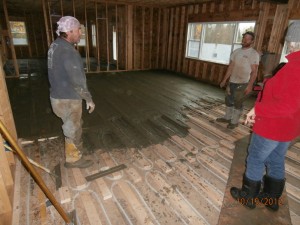 The ‘next big thing’ was going to be getting the radiant slabs poured, but the concrete guy was backed up, so we waited. And for the longest time, the sleepers and PEX tubing fastened to the floor turned walking across the room into a game of hopscotch. Finally, on Friday morning (10/19 ??) the concrete crew showed up. These guys are hard working, friendly and good at what they do, but really scruffy. It had been raining for a couple days, and they were glad to be working inside for once. The truck backed right up to the front door, filled off wheelbarrows, and they rolled them throughout the house. These slabs are going to be covered with flooring, so I wasn’t expecting a finely trowelled finish, but really, all they did was level them off with 1 pass with a 2×4. It’s good enough for what they’re for, but there will be no bare feet until we get some flooring in.
The ‘next big thing’ was going to be getting the radiant slabs poured, but the concrete guy was backed up, so we waited. And for the longest time, the sleepers and PEX tubing fastened to the floor turned walking across the room into a game of hopscotch. Finally, on Friday morning (10/19 ??) the concrete crew showed up. These guys are hard working, friendly and good at what they do, but really scruffy. It had been raining for a couple days, and they were glad to be working inside for once. The truck backed right up to the front door, filled off wheelbarrows, and they rolled them throughout the house. These slabs are going to be covered with flooring, so I wasn’t expecting a finely trowelled finish, but really, all they did was level them off with 1 pass with a 2×4. It’s good enough for what they’re for, but there will be no bare feet until we get some flooring in.
Whenever we pour concrete, we try to put our handprint somewhere. We didn’t do this on the footings or the walls or the slabs, so this was our last chance. I made a frame with some 2-by’s and wire mesh, and when one of the crew got wind of our plan, he put some serious effort into trowelling it smooth for us.
The ground was pretty soft from the rain, and although the first 2 cement trucks got in and out OK, they chewed up the front yard pretty good. When the 3rd load came, the truck sank up to its hubcaps. If you line up half a dozen guys and push on the rear bumper of a stuck cement truck, it’s still stuck. They called in a dump truck to pull it out. The whole crew took a break to watch before heading off to their next pour of the day.
With a smooth floor in place, the insulation contractor moved in on Monday with his spraying rig. Cold air and mice go right through fiberglass batts: they’re really more of a filter than an insulator. In Westford, after freezing for years, I tore out the batts and nests in the basement walls and sprayed them with foam. It sealed all the air leaks and made a huge difference, but it outgassed for about a month. This time, we used a soy-based foam, and there was no smell to speak of the next day. They sprayed an inch or 2 near the eaves to seal the leaks near the cellulose, 4″ between studs, and about 2″ on the concrete walls in the basement, behind the 2×4 frame-out. It took them 3 solid days of spraying to get it all done, and gave the place an erie greenish-blue glow. I was supposed to stay out of the house while they sprayed, but I found and fixed a couple of blocking errors which would have been cold spots, and had them re-spray them. I’m really happy with the way this came out.
A problem with sprayed foam is that, when you spray, your boxes, pipes and wires in the wall get encased in a rigid, plasticky mass, so you’d better get your wiring done right before you spray. I was pretty confident I had it right, but Shawn pointed out that I had a round light box poking thru the basement wall with no wire in it. So I spent 2 hours prying thru the foam with a putty knife, locating the boxes and running the missing wire. No doubt I’ll come across more like it.
At this point, the front of the house had a big-ass ugly expanse of blank wall above the windows. A neighbor had actually asked why we hadn’t put any windows in the 2nd floor.
The plan was to have a front porch with a shed roof complementing that of the garage, and taking advantage of the views and the afternoon shade. The details of the roofline kept eluding us to the very end. As Bernie says: “The solution will present itself when it comes time to build it.” And he’s right. With the grading done and the windows and garage roof in place, it was pretty clear where to run the outline and the roof. And since we’re kicked out of the house while the spraying happened, Now’s the time.
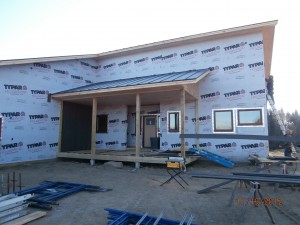
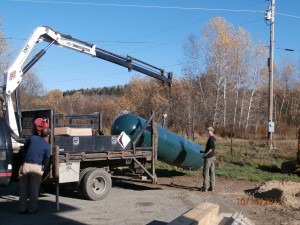 With cold weather on its way, we needed to get the heating system running soon, and we bought a 1000 gallon propane tank. Owning the tank means we aren’t married to a particular fuel dealer. With such a tight house, we expect to fill up just once per year and we can get a good price when we shop around for one big fuel buy. Bernie has a small excavator and buried the tank and the line and Bournes, the local dealer, hooked it up.
With cold weather on its way, we needed to get the heating system running soon, and we bought a 1000 gallon propane tank. Owning the tank means we aren’t married to a particular fuel dealer. With such a tight house, we expect to fill up just once per year and we can get a good price when we shop around for one big fuel buy. Bernie has a small excavator and buried the tank and the line and Bournes, the local dealer, hooked it up.
There is a new local fuel coop where we could get a good price on propane. The plan was to get the tank installed, plus a small delivery from the dealer to get started, and then buy a shitload of propane thru the coop. Well the coop took our entry fee and did nothing. I don’t think it is a scam, but the coop is just getting off the ground and they’re not ready for prime time. Meanwhile, they turned on the furnace using the 25 gallons or so that a new ’empty’ tank comes with and after running continuously to heat the slabs for a day or so, we ran out of gas.
So we ordered another 200 gallons from Bournes. The driver pumped 900. Mary got right on the phone and negotiated a really good price for it. But it turns out that the gauge on the tank is broken, stuck at 90%, and it’s almost like the driver wanted it to ‘read right’ once in its life, and kept pumping until it did. But we can’t be having a propane tank with a broken gauge, so they sent out a tanker and a technician, whose first attempt involved banging on the gauge. Still reading 90%. They replaced the dial. Still 90%. They pumped out 200 gallons. Still 90%. They pumped it dry and then purged it by burning the dregs in an open flame. Still reading 90%. They replaced the lever arm that floats on the liquid and then pumped in 200 gallons. Now it’s reading 91%. They did all this stuff again and now the dial is stuck at 0%. They pumped 200 gallons back in and went home stumped. With the furnace running, we really have no idea how much fuel is in the tank.
That night, I dreamed about propane gauges, replaying in my mind everything I’d seen that day. I woke up convinced that the lever assembly within the tank was built for an above-ground tank, and the 2′ riser tube which allows the tank to be buried was interfering with its operation. I drove down to Bournes to speak with the maintenance honcho, who said “no way.” So what’s the problem, I asked? What do we do next? “We don’t know, ” he said. “Maybe we’ll exhume the tank. Next year.”
It is my fond hope that the next time someone googles “Bournes Propane”, they’ll get this post. Buncha fuckin’ jackasses, if ya ask me.
Right about this time, Mary and I went to California. There were sheetrockers and roofers lined up to get started, and since the papered roof has a few leaks, Bernie was nailing a couple of tarps to the roof to protect the sheetrock in case it rains. Hurricane Sandy was heading our way, so we left 2 days early. I had a bad feeling about this.
The hurricane came and went. Vermont got off easy. We came back.
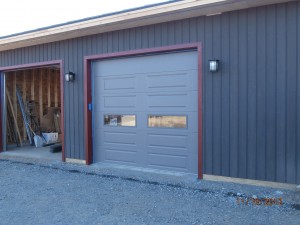 The garage doors had been installed. Wrong. Mary had spelled out, in writing, exactly how to order the panels: glass goes 2nd-from-the-top. They put the glass 4th-from-the-top.
The garage doors had been installed. Wrong. Mary had spelled out, in writing, exactly how to order the panels: glass goes 2nd-from-the-top. They put the glass 4th-from-the-top.
And the North door won’t go up and down.
Mary was bound and determined to get the garage door trim painted to match the windows, and used the tail ends of 2 nice days to prime and paint them red.
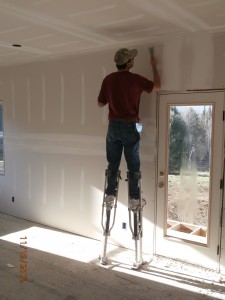 The sheetrockers had done all the ceilings and some of the walls by the time we got back, and then moved on to a different job. The main thing was that the ceilings were in place, so the blown-in attic insulation guys could get started. And since this was about the time when the furnace was running out of propane, the place was too cold to mud anyway, so they put us on hold.
The sheetrockers had done all the ceilings and some of the walls by the time we got back, and then moved on to a different job. The main thing was that the ceilings were in place, so the blown-in attic insulation guys could get started. And since this was about the time when the furnace was running out of propane, the place was too cold to mud anyway, so they put us on hold.
I wandered around, admiring their work, and noticed that a light switch was missing. And another. And a couple plugs. Sheetrocked right over, and nary a bulge in the walls. I’ve got all kinds of photos of what’s in the walls, and I located all 4 boxes with a hole saw. The guy said it had never happened before. By now, they are on the 2nd coat of mud, and it is already smoother than I’m usually able to get it after 4 coats.
When we left for California, the plan was to move full speed ahead on everything but the attic insulation. I wanted this to wait because I was going to use lag bolts thru blocking to cinch the antique beams into place against the living room ceiling, once it was mudded and primed. Well they decided that they can’t mud the ceiling until it was insulated, in case of a cold spell. And they’re probably right. So the morning we got back, the insulation truck was backed up to the garage, blowing cellulose into the attic at about a bale a minute. WTF !?! Since the front porch had gone up pretty much the day before we left, I’d held off on wiring the porch and flood lights, and suddenly I had a crisis on my hands. So I’m up in the attic with a flashlight and some tools, asking the masked man with the big hose to please ‘point that thing somewhere else’ while I run a few wires. That part was easy, but by the time I was ready to cut the hole to mount the box for the flood light, there was a sea of cellulose, 16″ deep, as far as the eye could see.
The hole I had to cut was 9′ up, and about 30′ away from the crawl-hole thru the ceiling, so my plan was to wade over there, screw a 2×4 to a truss brace, climb up onto it, and do the work. All with a flashlight in one hand. I got up into the crawl hole and gently put my 2×4 down on the insulation. It silently sank out of sight, leaving no scar on the surface. Did you ever drop a screw on a sawdusty floor and spend 15 minutes on your hands and knees looking for it? If I ever kill someone, I am going to haul the body up into the attic and leave it there. No one will ever find it. I did find the 2×4, and I eventually got the floodlight box mounted, but it was a bitch, and there is no way I’m going to be able to secure the beams from up there. In a way, this is good, because it means that cleaning and straightening the beams is no longer a crisis.
The siding has been going up for 2 weeks and they’re about as far as they can get without the roof being done. It is mostly “rustic channel” – sort of like vertical clapboards – and stained a dark grey called “dragon’s breath,” which we used on the garage in Westford. The gables and the south porch are red cedar shakes which Mary has been treating at the mill with her finish. It looks pretty good. The soffits are not going to get stained this year, but there’s still some discussion about what colors to use anyway.
The roof is finally done. It’s a standing seam metal roof, and they did a fabulous job. A 3-man crew from East Coast Copper put it on, and they got there early and worked until dark for 6 days. It is 7000 pounds of coated steel and everything about it is perfectly straight and true. It’s a work of art, and I couldn’t be happier about it. I had never seen standing seam get installed before. They spend a lot of time prepping the edges and once they get going on a flat expanse, it goes pretty fast. They haul a trailer housing a forming machine with a 1000# roll of stock on one end and an outfeed on the other, and it bends a continuous sheet into a 6-sided profile onto an outfeed table. The longest sections were about 32′, over the garage.
They walk the formed sheet up onto the roof, lay it flat overlapping the last piece, and crimp the first couple feet by hand. Then they put a power-crimper on a sled at the top and let it gravity feed down the roof. At the soffit end, there is a fair amount of hand work, but it all boils down to careful cutting and folding with snippers and pliers.
A problem with standing seam roofs is that there isn’t much friction to hold the snow in place, so once it starts moving, it goes, taking anything in its path with it, including antennas, plumbing vents, and chimneys. We moved the chimney placement at the last minute because the original spot was 6′ down from the peak of the roof, and they said that sooner or later, a heavy storm would shear it off.
For the plumbing vents, which are located near the peaks, I had expected that that they would poke the PVC pipes through a stock boot, but they promised that this would fail too. They soldered together a stainless steel assembly to enclose the pipe, crimp/joined it into a normal section of steel and then spiral-rolled the top of it over the PVC for an extremely sturdy and weatherproof housing. Very impressive. As it turns out, these guys do a lot of high-end commercial sinks, countertops, and decorative sheet metal work during the winter months. They know what they’re doing, and it shows.

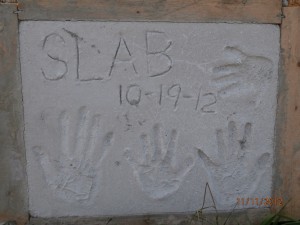
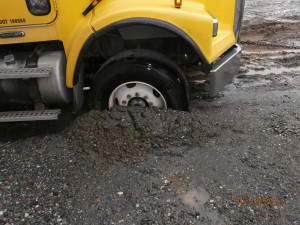
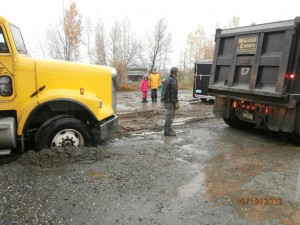

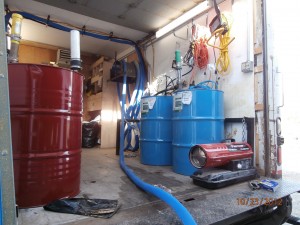
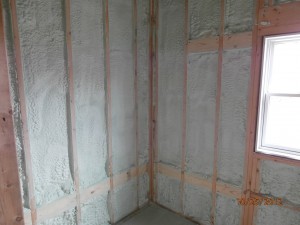
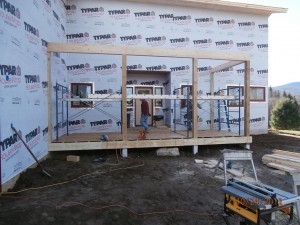
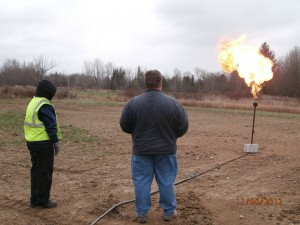
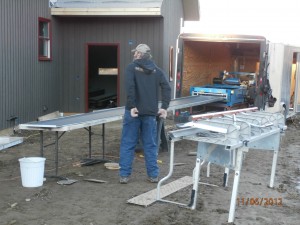
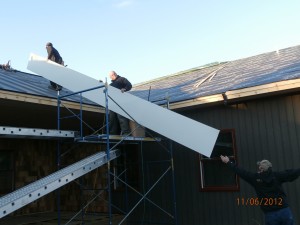
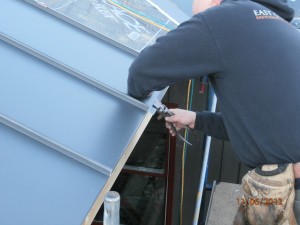
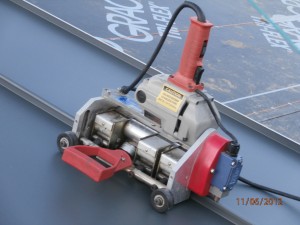
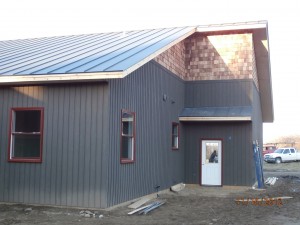
One Response to Big visible progress